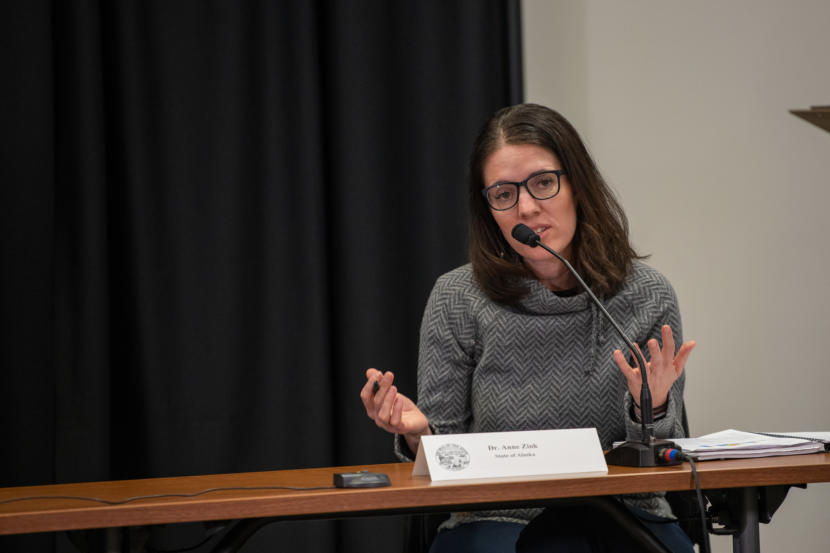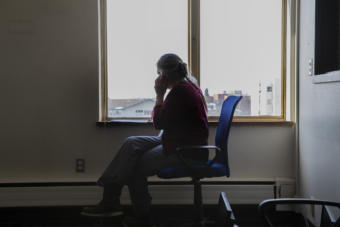
Alaska’s chief medical officer gave several reasons on Wednesday for why Alaskans should wear masks when they can’t stay six feet away from others. But she didn’t say that they have to do it.
Some Alaska lawmakers said they want to know why the state hasn’t announced more changes in response to the recent rise in COVID-19 cases in the state.
Over the past month, the number of confirmed, active cases of the virus has grown from roughly 50 to more than 300.
Rep. Tiffany Zulkosky, D-Bethel, said that many Alaskans aren’t following advice from state officials to wear masks when social distancing isn’t possible.
So, she asked Alaska Chief Medical Officer Dr. Anne Zink about it during a House Health and Social Services Committee meeting:
“Would you advise a temporary mandate where social distancing isn’t possible, to be effective in curbing the spread of the virus in Alaska?” Zulkosky said.
Zink said scientific data is increasingly showing that wearing a mask is an important tool in stopping the coronavirus.
“From a health perspective, my goal is to have as many people wearing masks when they can’t social distance as possible, and whatever tools we can use to get there,” she said. “There’s a lot of debate on which tools are most effective, for all sorts of different reasons. But we just need to try to address the message consistently that a mask is an important tool moving forward.”
But Zink said the state isn’t emphasizing broad mandates, opting instead for more “surgical” and geographically targeted responses to outbreaks.
On Friday, Anchorage Mayor Ethan Berkowitz announced a mandate for residents there to wear masks in all public, indoor spaces.
And Zink said many Alaska businesses have been proactive on masks.
“I think it’s important to remember the virus is the enemy here, and not each other, and to see businesses being able to come together to be able to mitigate this disease has been fantastic,” she said.
Zink acknowledged that fatigue with the pandemic has set in.
“I think all of us are over COVID,” Zink said. “It’s no fun, but COVID really sets the timetable.”
Zink said the recent rise in cases is different than the one that occurred in March. The state is catching more cases due to increased testing. And each case is receiving more contact tracing since the state has expanded its capacity.

State officials said they’re aiming to have 500 people doing contact tracing, up from the current number of roughly 140, though they gave similar numbers more than a month ago. School districts are being added as partners, including school nurses.
State Epidemiologist Dr. Joe McLaughlin also addressed the legislators during the meeting.
“Until we have an effective vaccine or treatment for COVID-19, we need to continue to rely on non-pharmaceutical, public-health interventions to slow the spread of this virus,” he said.
National experts estimate roughly 10 times as many people have contracted the virus as have tested positive for it. McLaughlin noted that if that’s true in Alaska, only roughly 1 percent of Alaskans have contracted it.
Some critics of the public health approach have said the state should try to reach what’s known as herd immunity — a level where enough people are immune to the virus after having contracted it that it’s no longer spreading. But that level is estimated at 60 to 70 percent of the state’s population. And thousands of Alaskans could die to reach that level.
Zink said Alaskans should continue to work from home if possible.
“In general, if your work can be done via telework or other remote ways, we highly recommend it,” she said. “Our office is teleworking: Dr. Joe McLaughlin and I — we were joking that we ran into each other on a trail and had not seen each other since this pandemic started.”
Zink said it’s not possible to isolate only those who are at high risk from the disease.
“We often get asked, ‘Why don’t we just kind of protect a small group?'” she said. “It’s not a small group: It’s at least a third of us.”
Using Centers for Disease Control and Prevention definitions, 32 percent of Alaskans have been identified as having one or more risk factors.
